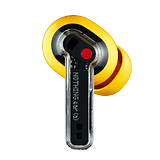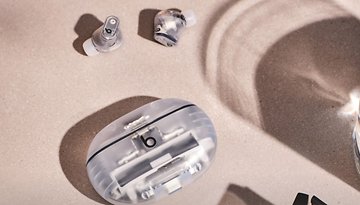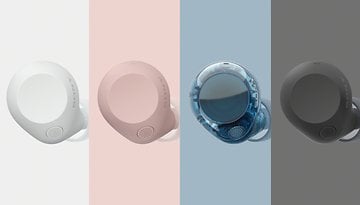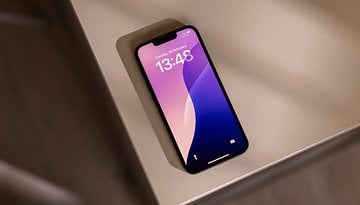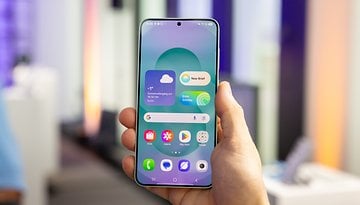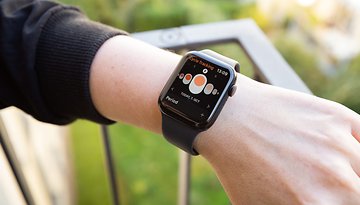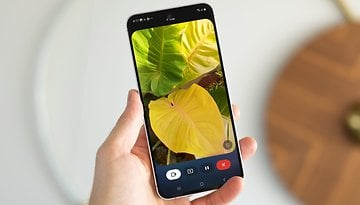Nothing Ear (a) Review: Amazing Performance for so Little
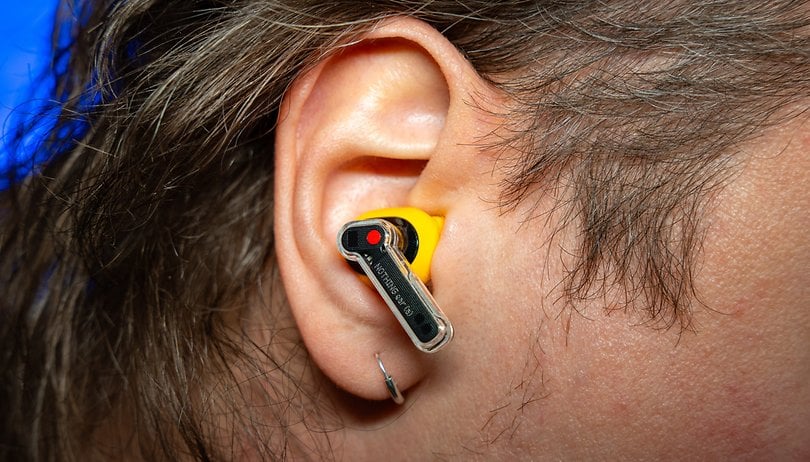

Although Nothing already offers affordable in-ear headphones, the Ear (a) is yet another addition to their growing stable of offerings! The earbuds come with Hi-Res certification, ANC, wireless charging, and IP certification but costs only $99. There is no US pricing just yet. In this review that we were able to perform before the launch, we wore the earbuds in our ears all the time. Stay tuned to find out whether the purchase is worth it!
Good
- High quality sound thanks to LDAC and Hi-Res certification
- Powerful, adaptive ANC
- Dual pairing and low-latency mode
- Quick charging and wireless charging
Bad
- Charging case is a little fiddly
- Average battery life
- Tend to be bass-heavy
- Yellow color variant is limited for now
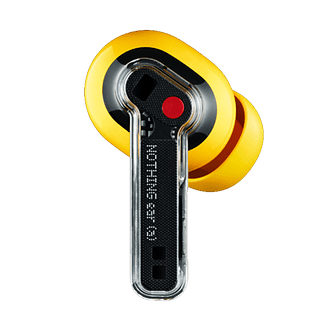
The Nothing Ear (a) in a nutshell
Nothing continues to manage the high-wire balancing act between a wealth of functions and technical excellence in the Ear (a). The earbuds, which cost just $99, offer many features such as wireless charging, LDAC support, dual pairing, and adaptive ANC that still impress in terms of sound and ANC performance. The only points of criticism would be the rather fiddly charging case and average battery life. You obviously need to like Nothing's design too!
By the way: Nothing also launched the "Nothing Ear" together with the Ear (a). These are Nothing's new flagship earbuds that costs just under $150.
Design & build quality
The fact that Nothing wants to do everything differently with the Ear (a) is evident from the packaging. The Ear (a) comes in bright yellow cardboard box. Inside lies a really curious charging case with a transparent lid and the earbuds within. These are also bright yellow, but are extremely comfortable due to their weight of just 4,8 g.
Pros:
- Comfortable fit due to its lightness.
- Refreshing unconventional design.
- CO2 footprint is only 2.72 kg.
- IP54 dust and water protection
Cons:
- The charging case can be quite difficult to open/
- Inserting the earbuds takes some getting used to.
With the Ear (a), Nothing is launching an alternative to the Nothing Ear (1), which is also available for $149. For the very first time, Nothing deviates from the typical black and white look and offers a special yellow version. As Nothing informed us before the launch, this could also be available on a permanent basis if it is well received. Personally, I like it, especially since it makes the earbuds easier to find.

As is typical with Nothing, the rest of the design takes a little getting used to. The charging case has a fairly wide "lip" that closes around the colored inner segment. There is a small recess in front which should make it easier to open the case. In my opinion, this makes the charging case a little fiddly. I would have preferred a more classic design, even if it looks a little more boring when placed against the light.
I had a similar feeling when inserting the earbuds into the charging case. To insert them, you have to turn the small, lightweight earbuds outwards so that the magnets will help them click into place for the charging contacts to align. This is a little but unintuitive and doesn't become second nature even after a while. Another negative aspect is how Nothing's new charging case creaks when you apply just a little pressure. The manufacturer has already done much better earlier.
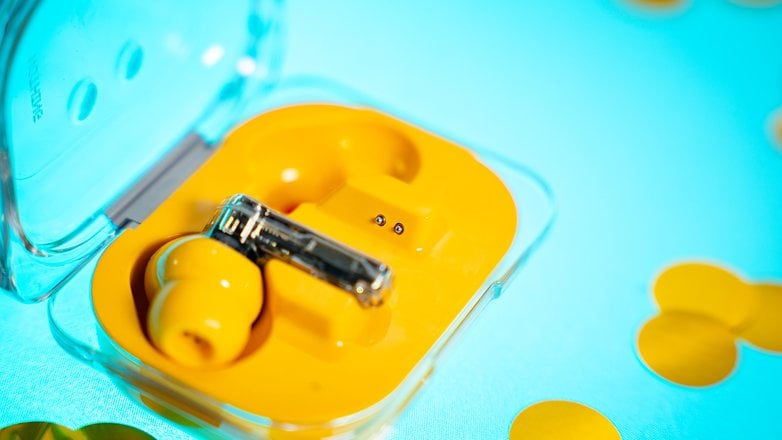
What Nothing did really well, however, is having a high level of wearing comfort. The earbuds of the Ear (a) have replaceable silicone tips, which means they seal the ear canal passively. As the weight of the individual earbuds is extremely light at 4.8 g, it is easy to forget you are wearing them. They also sit firmly enough to prevent them from falling out of the ear when you indulge in sporting activities or when shaking your head.
Thanks to IP54 certification, both the earbuds and the charging case will also shrug off water splashes. Nothing ensures its water resistance is further augmented by using squeeze gestures instead of touch-sensitive surfaces. You press the earbuds together to operate them, preventing incorrect entries in the rain or when adjusting the earbuds. Personally, I think this is the best way to control the earbuds.
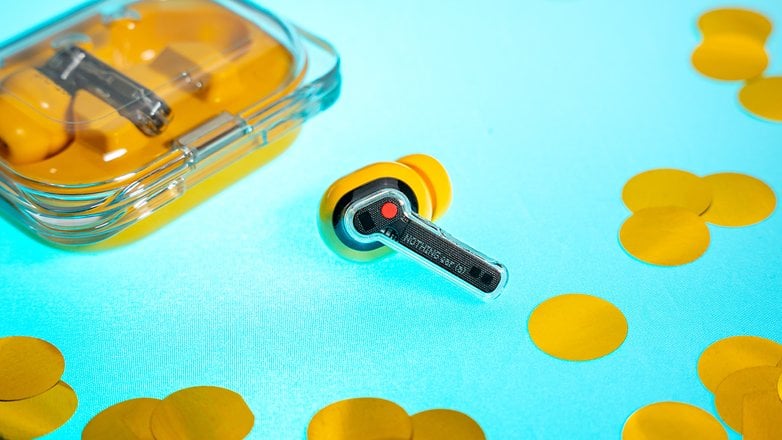
Last but not least: Nothing also emphasized the sustainability aspect with the Ear (a). For instance, the production of the earbuds would only result in 2.72 kg of CO2 equivalents. In addition, 100% recycled soldering iron is used. So-called lifecycle assessments of other earbuds, at the end of which the CO2 equivalents caused are calculated, can hardly be found online. An article Ecochain's website, which was obviously sponsored by the manufacturer Skullcandy, gives this value for earbuds as 5.9 kg. Whether the Ear(a) is really more sustainable is therefore difficult to prove. As always, however, if you really want to live sustainably, you'd be better off buying wired headphones!
App & convenience functions
You can connect the Ear (a) to the Nothing app on both iOS and Android. The manufacturer provided us with the beta version of the application, allowing us to take a look at the functions and settings from where you can control via the smartphone. Convenience features such as wearer recognition, adaptive ANC, and support for Google Fast Pair for $99 are definitely impressive!
Pros:
- Wonderful Nothing app design.
- Many comfort functions and setting options.
- Multi-device pairing up to two devices.
Cons:
- Battery warning tone is too discreet.
Rarely have I had so few complaints about a manufacturer's app as I did with the Nothing X app. Our beta version worked perfectly on a Sony Xperia 10 III and it was particularly impressive in terms of design. As with the earbuds, Nothing conveys a clear design language and seemed to have invested a little money in the UX design. Although the application offers many functions, it continues to remain very intuitive.
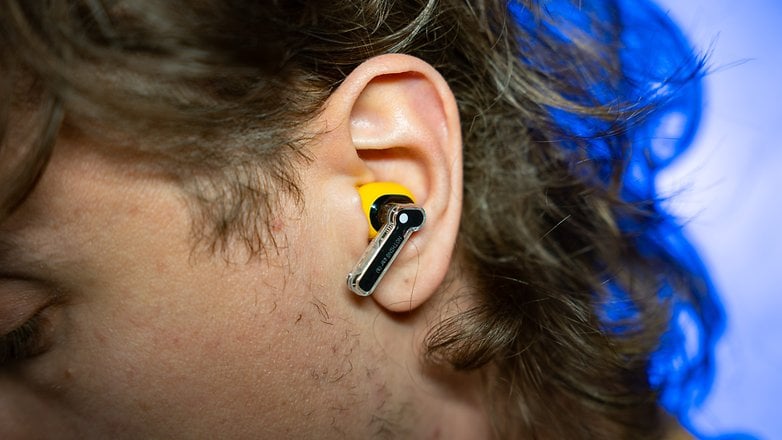
As for the settings, you can change the operation of the earbuds, read out exact percentages of the battery status for the case and each individual earbud, and optionally switch to adaptive ANC. In addition, Nothing managed to integrate multi-device pairing for up to two devices smoothly despite the relatively affordable price. Even switching between Android and iOS went smoothly and, thanks to Bluetooth LE, the earbuds can always be controlled by both smartphones.
If you are on the Android ecosystem, you also benefit from Google's Fast Pair standard. This allows you to link the earbuds to your Google account and use them wherever you are logged in.
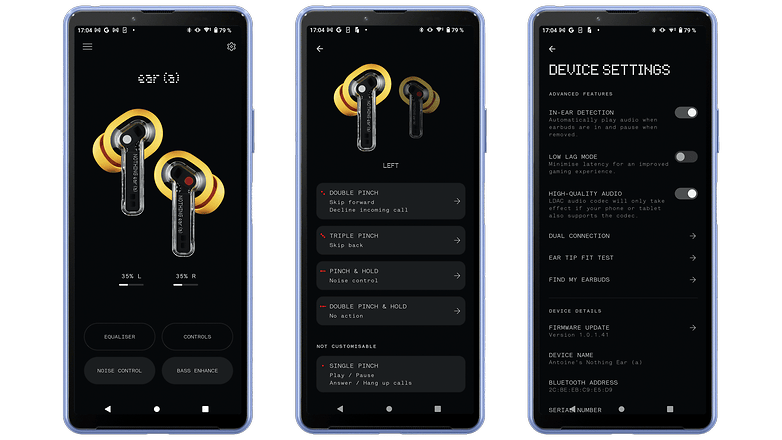
The only disadvantage I noticed in terms of software and comfort functions was Nothing's discreet warning tones. When the earbuds' battery runs low, you can sometimes hear a soft knocking sound. This is not noticeable enough for me to understand that the earbuds are about to run out of juice.
Sound quality & ANC
The ear (a) contains 11 mm dynamic drivers with ceramic diaphragms and a frequency response of 20 Hz to 20 kHz. In terms of Bluetooth codecs, Nothing relies on both SBC and AAC, but also provides the high-quality LDAC codec that works with Android devices. The adaptive ANC was designed to suppress ambient noise by up to 45 dB and offers a transparency mode.
Pros:
- Good and flexible sound thanks to LDAC and equalizer.
- ANC is more convincing than the price suggests.
- High maximum volume.
Cons:
- Technically quite a small frequency range.
- Quite bass-heavy overall.
If we were to look at the Ear (a)'s technical specifications, a few things stand out. First, there is the rather limited frequency range of 20 Hz - 20 kHz, which is surpassed by many more expensive models. Second, there is adaptive ANC, which can adapt to the environment that we cannot find in many earbuds under the $100/€100 price point. Support of the LDAC codec is also welcome, even if we can only enjoy this advantage on Android.
The LDAC codec allows you to enjoy high-resolution music, provided you use the required source. For the review, I downloaded a test file in FLAC format, but apart from that I only used premium streams on Spotify. Read Antoine's detailed BT codec report to find out why the LDAC codec ensures the Nothing Ear (a) are Hi-Res certified and what advantages the codec offers.

When we wear the Nothing Ear (a), we noticed one thing in particular: a certain tendency that leaned towards bass. Even if the low frequencies were technically a little lacking compared to other earbuds, the Ear (a) still delivered bass-heavy music really well. This may be partly due to the high overall volume of the drivers, which have enough muscle to deliver powerful bass.
However, this may also have something to do with Nothing's Bass Enhance technology and the preconfigured equalizer. Fortunately, both can be disabled and changed to suit your preferences. The graphic equalizer, which you can see in the screenshots, worked really well, but upon closer inspection, it turned out to be a 3-band equalizer. Other inexpensive earbuds such as the Earfun Ear 3 Pro offer more, but I really like the Nothing EQ for simple changes.
Hence, I have to admit that I really liked the sound of the Nothing Ear (a). I didn't notice any clipping in any frequency range, regardless of the volume, the clarity is excellent, especially with LDAC, and thanks to the equalizer, the sound is also easily adjustable.
The Active Noise Cancellation also performed well in the review. With an output of 45 db, it is slightly better than the Nothing Ear (1)'s (review) according to the technical specifications. It is perceived to be effective and, above all, noise-free when suppressing sounds of the Berlin spring. Cars, drilling neighbors, and birds disappear when ANC is fully activated and are only slightly audible. If you want to remain alert, you can control the noise suppression in four stages and activate a transparency mode.

A new feature is the adaptive ANC, which automatically reacts to the volume of your surroundings. For instance, if you were to go from a quiet office to a noisy street, the ANC becomes more pronounced. Nothing also described the "Smart ANC" feature as reactive to the fit of the earbuds. If they do not fit perfectly in the ear, the earbuds increase the noise suppression to ensure better noise cancellation. However, I didn't really notice any difference in the review by partially pulling out the earbuds.
Nevertheless, the ANC of the Ear (a) is around 13% stronger than the ANC of the Nothing Ear (2), the manufacturer's most powerful ANC buds to date. As the Ear (2) cost $149, this is quite remarkable.
Last but not least: you can also make phone calls when you wear the Nothing Ear (a). The presence of three microphones ensure good call quality. This was confirmed to me by the other party in the test call. I was also able to understand my mother well!
Battery life & charging
With a battery life of up to 8.5 hours without ANC and up to 5.2 hours with ANC, the Nothing Ear (a) remain in the mid-range for true wireless earbuds. However, as Nothing incorporated a 500 mAh battery in the charging case, this results in a long-lasting total runtime of up to 40.5 hours. Quick charging provides 10 hours of runtime in just 10 minutes, and wireless charging is also on board.
Pros:
- Solid battery runtimes.
- Quick charging on board.
- Wireless charging.
- Precise information of the battery level in the app.
Cons:
- Runtime is average at best
- Battery warning tone is too discreet.
As an ideal case for true wireless earbuds, I like to measure the battery life based on an entire working day, i.e. 8 hours. The Nothing Ear (a) achieved this as long as you can live without Active Noise Cancellation. If you have to block out your colleagues or ambient noise while working, the runtime drops to 5.2 hours, so you have to charge them briefly during your lunch break.

Nothing also integrated a quick-charging function into the affordable earbuds, letting you charge them for up to 10 hours via the charging case. The earbuds need just 10 minutes for this, although Nothing discreetly added that this information refers to use without ANC. You can charge wirelessly via 2.5 W using the Qi standard, which is quite a special feature for earbuds under $100.
The only thing I would criticize about the Nothing Ear (a) is the discreet battery warning tone. As mentioned in the segment about its operation, the Ear (a) only emitted a soft knocking sound when the battery began to run low, which cannot always be clearly identified as a warning tone.
Final verdict
Technically, the Nothing Ear (a) does not differ too much from the Nothing Ear (1), which the manufacturer introduced around two and a half years ago. The inclusion of LDAC and the resulting Hi-Res certification are welcome. In addition, Nothing ventured a little further by delivering an exclusive yellow color variant. Nothing was able to improve the battery life, as it now finally offers over 8 hours of runtime without ANC.
Why am I comparing this to Nothing's first headphones? Nothing once again offers the Ear (a) for $99 and therefore, offers high-performance and "unique" earbuds within the sub-$100 price range. If you need more performance, you can alternatively opt for the "Nothing Ear", whereby the manufacturer transfers the model policy of its smartphones to earbuds.

Sound quality was particularly impressive in the review with Android devices and activated LDAC. ANC is still good, and the fact that it is now adaptive is a nice addition. What's rather unpleasant is the handling of the charging case, which has a narrow lip, making it rather awkward to open.
